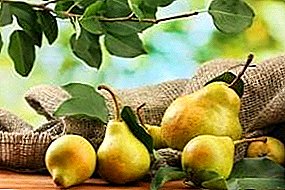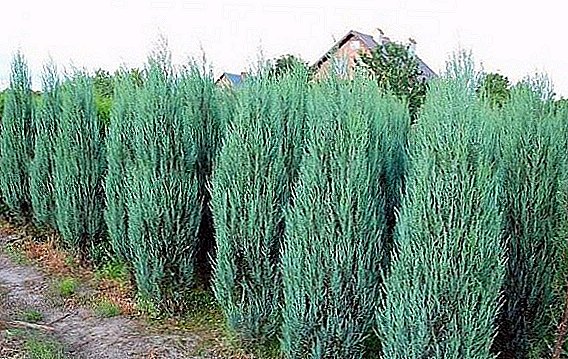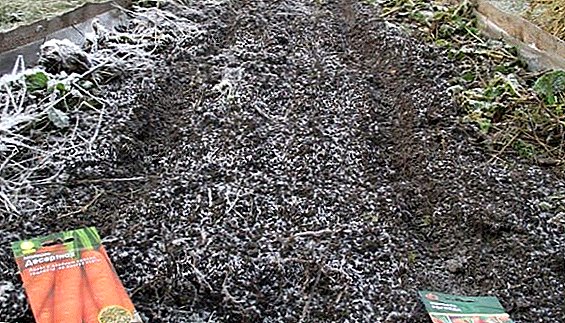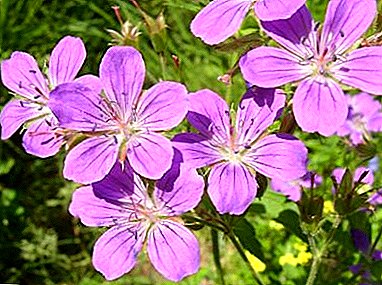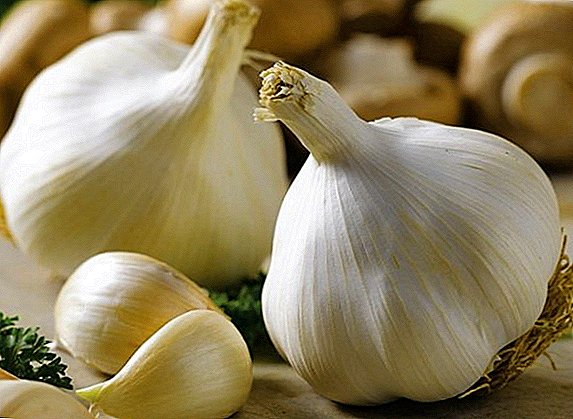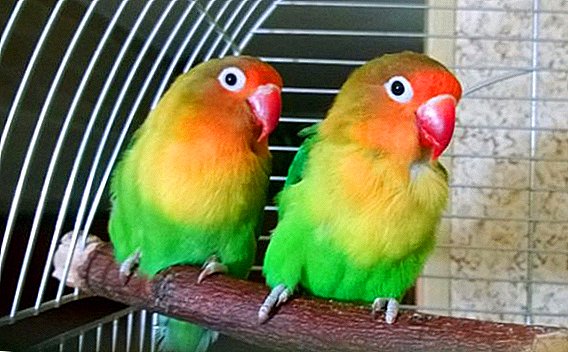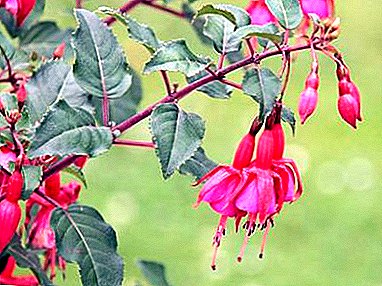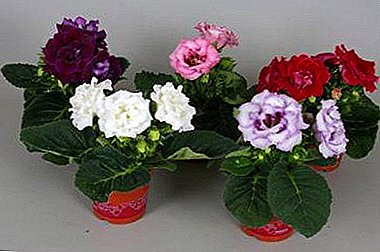
Bright flowers and ornamental gloxinia leaves have always attracted the attention of breeders who develop new varieties and hybrids.
Velvety gramophone notes of bright saturated colors inherent in this variety series will be relevant in the office, apartment, on the window of a village house.
The variety of the terry Gloxinia Sonata, which characteristics will be discussed below in the article, also applies to fresh hybrids.
The article will look at how to care for this flower, as well as talk about the features of its reproduction.
General characteristics
Gloxinia (Gloxinia) - a perennial herbaceous or semi-shrub plant of the genus Gesneriyev (Gesneriaceae). In nature, it forms colonies along the banks of rivers, on rocky ledges, in damp, shady tropical forests of South and North America.
History of
Gloxinia was first described in the 18th century by Alsatian naturalist Benjamin Peter Gloxina, who discovered a flower in Brazil. The naturalist called him by his name, adding the epithet "speckled."
Botanical description
 The most important generic signs of gloxinia:
The most important generic signs of gloxinia:
- Most indoor gloxinia tuberous plants. The tuber is large (up to 40 cm in diameter), rounded, scaly.
- Stem short, glabrous or slightly pubescent.
- The leaves are thick, fleshy, juicy, intense light, dark green, silver, with a velvety surface.
- The bottom of the leaf is green, reddish or purple. The location is opposite or ternate. Sheet plate oval or elongated. Width varies from 1 cm to 20 cm. Petiole thickened, dense. Outlet height from 2.5 cm to 30 cm.
- Peduncles are from 1 to 15 cm long. Single flowers have the form of a glass, a funnel, a bell, a gramophone, a cup, but all have a wide pharynx and an elongated tube divided by a five-petal tube halo with five stamens, four anthers and a long pestle.
- Flowers are large (8-12 cm in diameter), simple, semi-double and terry, multilobed with a simple, corrugated or wavy edge.
- On one plant can bloom from 1 to 20 flowers. The color range is varied, excluding yellow and brown. The flowering period from early spring to late autumn.
- The fruit is a cone-shaped box with many brown small seeds.
Varieties
Botanists number from 20 to 25 species of gloxinia, but only varieties and hybrids bred on the basis of several species and their varieties are grown as home crops: speckled gloxinia, royal syngia, beautiful blue syngia, terry gloxinia.
Appearance and features
Gloxinia Sonata is a variety series of hybrids bred on the basis of terry varieties of Gloxinia. It features a large number of large pink, purple or red flowers on a single plant, compact sheet rosette.
The following types are best known.
"Sonata Light-purpurple" ("Sonata light purple")
It has flowers with a wide open purple-violet throat in the shape of a cup and delicate lilac-white petals with lilac border.

"Sonata Pink" ("Sonata pink")
A hybrid with a flower with a throat saturated coral-pink and white and pink petals.

"Sonata Rose" ("Sonata Rose")
Exquisite pink hybrid, two-tone flower throat, above dark pink or pink red, cream below with cherry specks.

"Sonata Red" ("Sonata Red")
Intense red hybrid.

In flower shops you can find Sonata gloxinia seeds with a "mix". This is not a separate variety, but a mixture of several hybrids of this variety with flowers of different colors.
- Kaiser Wilhelm and Friedrich.
- Shagan.
- Krasnoyarsk.
- Brocade.
- Rosalind.
- Yesenia.
- Terry white.
- Gloxinia Pink.
- Gloxinia hybrid.
- Curly liana - Gloxinia lofos.
Where and how to plant?
Gloxinia can be planted in several ways., but the most common is planting a tuber.
Landing Instructions:
- The tuber is cleared from the ground, dried roots. Disinfected in a light pink solution of potassium permanganate, placed in a solution of growth stimulator for indoor plants. When soaking, ensure that the solution does not fall into the upper funnel of the tuber.
- For planting choose a wide and shallow pot. For young plants usually take pots with a diameter of 7-10 cm, for adults - 11-15 cm. Between the wall of the pot and the tuber leave a gap of about 3-5 cm.
- A drainage layer is poured into the pot, the width of which should be equal to 1/3 of the tank height.
- Pour soil mixture or ready-made soil for flowering plants, well moistened.
- The tuber is placed in a funnel up flush with the surface of the soil, sprinkled with a centimeter layer of earth.
- The seedling is placed in a pan with water, covered with a plastic bag, put on a well-lit place, keep the temperature + 22-25 ºC. The plant is ventilated daily for 10-15 minutes.
- With the advent of two true leaves, the top of the package is opened slightly for acclimatization of seedlings. After 3-4 days the shelter is removed completely.
- At the grown-up plant sprinkle a tuber on 1-2 cm.
Lighting and location
For gloxinia choose a place with good ambient lighting. Best on windowsill windows oriented to the west or east. When located on the south window, the plant needs shading, on the north - additional lighting.
Soil requirements
For the Sonata are slightly acidic soils with an acidity index of pH 5.5-6.5. In domestic conditions, the soil mixture is prepared from leaf soil, peat, river sand in the ratio: 1: 1: 1/2.
Home care
Like many tuberous plants, the period of active growth of gloxinia alternates with the period of rest. This feature should be considered when leaving.
Temperature
During the period of active growth and flowering, the daily temperature is maintained at + 20-22 ºC, night about + 18 ºC. During the rest period + 10-14 ºC. In drafts and with a sharp change in temperature, the plant rots and perishes.
Humidity and watering
 Optimum humidity of air in the room is 70-80%, permissible not lower than 50%. The lack of moisture is signaled by a slowdown in growth and a bending edge of the leaf plate to the bottom. To create the necessary mode, the plant is placed in a pan filled with water or moss, which is regularly moistened with expanded clay. Gloxinia can not be sprayed. When water gets on the leaves appear yellow-brown spots.
Optimum humidity of air in the room is 70-80%, permissible not lower than 50%. The lack of moisture is signaled by a slowdown in growth and a bending edge of the leaf plate to the bottom. To create the necessary mode, the plant is placed in a pan filled with water or moss, which is regularly moistened with expanded clay. Gloxinia can not be sprayed. When water gets on the leaves appear yellow-brown spots.
Watering is carried out through the pan or along the edge of the pot with separated soft water with a temperature of 2-3 degrees above room temperature. The soil should always be moderately wet, water stagnation is unacceptable. Half an hour after watering, excess water is poured from the pan.
Top dressing
The first 1.5-2 months after planting fertilizing is not required. In the active period, the plant is fed at least four times a month, alternating organic and complex mineral fertilizers. During the rest period, fertilizers are not applied.
Transfer
With the release of the plant from the "hibernation", during the growth on the tuber of new leaves, the tuber is transplanted into a new pot with a diameter of 2-3 cm more than the previous one.
Common diseases and pests
Gloxinia is characterized by diseases of the tuberous indoor plants:
- Fusarium;
- late blight;
- downy mildew;
- viroses;
- askohitoz;
- anthracosis;
- phyllostitosis;
- bacterioses.
If preventive measures are not applied on time, pests can cause irreparable harm:
- thrips;
- cyclamen and red spider mites;
- whiteflies;
- mealybug.
Breeding features
 Gloxinia propagated by seed and vegetative way: division of tuber, leaf and stem cuttings, leaf.
Gloxinia propagated by seed and vegetative way: division of tuber, leaf and stem cuttings, leaf.
For Sonata gloxinia, which belongs to hybrids, the seed method of reproduction does not quite fit, because the varietal characteristics when propagated by seeds are rare, it is better to use the vegetative method:
- To obtain a leaf stalk cut the bottom sheet during budding or flowering. The leaf is immersed in water by 1-1.5 cm. Water is not changed, but added as it evaporates. After the appearance of the nodule, it is planted in the ground, deepening by 2-2.5 cm.
- If, after the activation of the tuber, many lateral shoots have formed, the extra ones break out, leaving 1-2 of the strongest ones. The stalks are rooted and planted also as leaf stalks.
- For reproduction by a sheet plate with a sharp knife cut a large sheet at the base of the rosette. On the inner side, transverse incisions are made on the largest veins in the thickened areas. The sheet is placed on a moist soil, pressed in the places of incisions, covered with a film. After the appearance of the roots, the formation of tubers, the leaf can be rooted.
- When breeding by dividing the tuber, it is cut into pieces so that each has 1-2 growth buds or shoots. Cuts are burnt with charcoal, laid out to dry in a dark place for 2-3 days, planted.
Similar flowers
Gloxinia Sonata resemble room cultures:
- Streptokarpus is a relative of Gloxinia from the Gesneriev family. Perennial herbaceous plant without stem, from 5 to 30 cm high.
- The representative of the Gesnerievs - Ahimenez. For pubescent elongated leaves in the people it is called "nettle".
- Another flower from the family of the Gesnerievs is Koleria. Her leaves are velvety, dark green. Flowers form an elongated, modified bell with five large petals of different colors.
- Campanula resembles Gloxinia flower shape. Differs abundant flowering.
- The royal pelargonium or geranium is famous for its large, densely-colored flowers. It has an oval spot of a contrasting color in the middle of the petal, which gives it an unusually beautiful look.
Gloxinia Sonata does not require special care and will decorate any interior.


